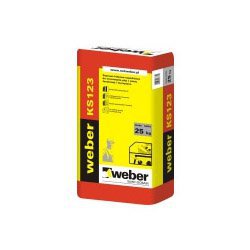Weber - adhesive mortar for styrofoam KS123
Price on request
Product description
Weber KS123 adhesive and putty mortar for fixing white and graphite foamed polystyrene (EPS) insulation boards and making a reinforced layer on them. The product is supplied in the form of a dry powder mix, ready for use after mixing with water at the construction site.
Application
- Reinforcing layer on white and graphite (EPS) insulation boards
- Fastening insulation boards made of white and graphite (EPS)
- Removing small unevenness in the ground
- Fastening light architectural details
- Fastening expansion, window, under window sill profiles, etc.
properties
- short time for initial binding of the product
- increased resistance to changing weather conditions
- for manual and machine application
- hardy after binding
- plastic when fastening and filling
- very good grip
Substrate preparation
Sticking insulation boards
Remove the antennas, masts etc. installed on the surface of the insulated wall. Cover windows, doors, terraces and other elements that can be damaged. Before starting work, check the condition of the ground and compare it with the design assumptions. The substrate should be stable, sound, dry, not greasy, freeze-free, free of dust, free from efflorescence in salt and loose parts. In the case of insulation of buildings with concrete sandwich panels, it is necessary to assess the condition of the textured layer. Sealing putty filling the joints between the panels must not come into contact with polystyrene. In the case of insulation of buildings in operation, the entire surface should be thoroughly washed with water under pressure. Plaster fragments with poor adhesion should be removed and supplemented with Weber adhesive mortar. Strongly absorbent and sandblasting surfaces should be thoroughly cleaned and primed with deep penetrating liquid PG229 weber.
Smooth surfaces should be thoroughly cleaned and primed with a priming liquid and weber PG215 quartz sand. Wall surfaces made of ceramic tiles, mosaics, wood or wood-based panels, drywall or previously made ETICS can be insulated based on individual technical approvals and individual recommendations.
When assessing building sub-bases, the assessment should be carried out for each building separately. If in doubt, pull-off testing should be performed. The prepared surface should be collected and confirmed by an entry in the construction log.
Making the reinforced layer
Possible unevenness of the contact in and surfaces of previously glued thermal insulation boards should be sanded, vacuumed and leveled. Install corner strips, expansion profiles, window sill profiles and corner reinforcement mesh around openings in windows and doors, etc. Install load-bearing elements on which the roofs, handrails, blinds, etc. will be mounted. Perform additional mechanical fastening in accordance with the assumptions indicated in the technical design. The prepared surface should be collected and confirmed by an entry in the construction log.
Warning! When carrying out insulation works using graphite polystyrene, the entire scaffolding should be covered with facade grids. This is related to the thermal work of the panels and their low resistance to UV radiation.

